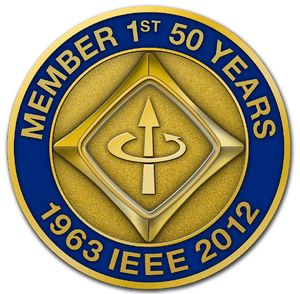First-Hand:Semiconductors at Purdue and Beyond: Difference between revisions
(Created page with "== Semiconductors at Purdue and Beyond == thumb|right I was an electrical engineering student at Purdue in the years starting in 1942 through earl...") |
(No difference)
|
Revision as of 12:53, 16 July 2012
Semiconductors at Purdue and Beyond
I was an electrical engineering student at Purdue in the years starting in 1942 through early 1944 when the Navy found need for an electronics technician having poor eyesight. While my chosen field was electrical engineering, I found physics very much a part of my education and accordingly was selected by the Freshman Physics Professor, Dr. Abbott to assist in one of his military projects as a technician. Later he assigned me to freshmen class physics laboratory instruction.
My association with physics instructors and graduate students offered many opportunities for collection of information regarding research in the Physics Department. One of these projects was being led by the Department Chairman, Dr. Lark-Horowitz, to determine the physical properties of semiconductors. One of the materials that seemed to collect my interest was germanium. While there was a known capability inherent in several semiconductors to slow or stop conduction of electrical charges, there seemed to be more inherent capability for germanium, when mixed with other 'doping materials' to obtain unusual control of electron flow. I reported some of this information to student friends and professors (those who would listen to a 'student'). Largely, my information was not considered very important and often I was advised to attend to my electrical engineering studies and not give much attention to “physics projects that would not achieve any useful product or material benefit”. Such was the secularization of university departments at that time!!
Before I was called for duty, I learned that some of the material generated in the physics lab experiments was provided to the Bell Laboratories, Dr. John Bardeen, who had been excited about the solid state physical properties of the germanium semiconductor. I don't recall telling any of my EE professors that information but stuffed it away in my own mind to be recalled after the transistor was developed and for which a Nobel prize was awarded to Dr's. Bardeen, Shockley and W. H Brattain.
The transistor invention was announced in 1947 as I completed my Purdue EE degree following service. When the inventor were announced, I recalled the incidental information earlier stored in my mind. My former contacts with the Physics Department had left the department or didn't remember me, or would not or could not verify that the semi conducting germanium provided the Bell Labs was indeed that which made the transistor able to amplify electronic signals. However, I certainty know there was a strong relationship of Purdue Physics Department personnel and the Bell Telephone Laboratory in which the germanium transistor was developed.[1][2]
I enjoyed opportunities to remind my former EE professors, who had disregarded that foundational research from which sprang a continuing growth of electrical and electronic wizardry.
David M. Hodgin, Sr. Life Member and former Director of IEEE.
